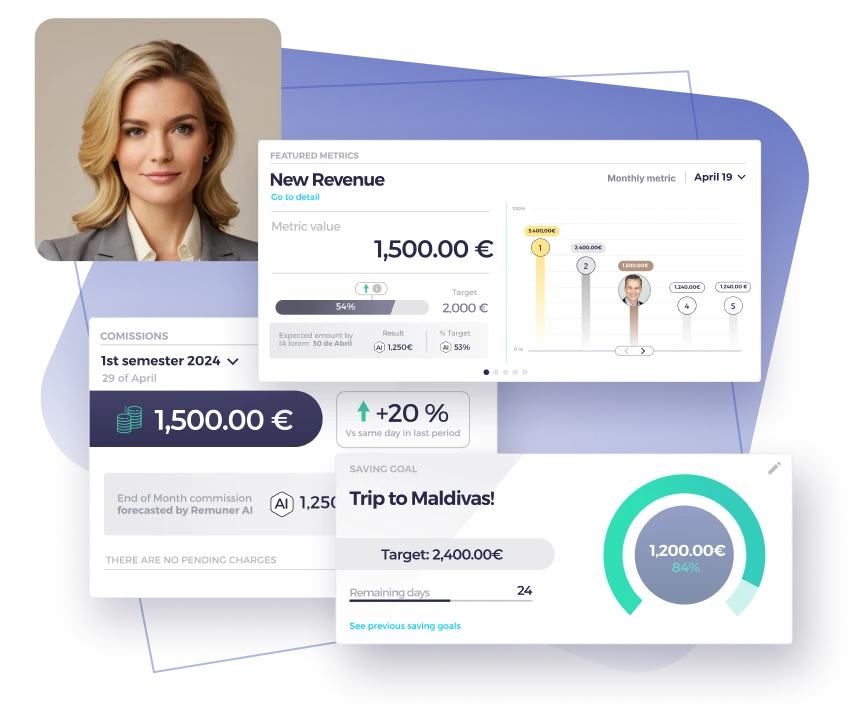Table of contents
What is compensation analysis?
Compensation analysis means looking at how much you pay your employees—and comparing it with what the market pays. The goal is to make sure your pay is fair, competitive, and aligned with your business strategy.
It includes:
- Reviewing base salaries
- Comparing commission plans and incentives
- Checking pay equity across similar job roles
- Updating compensation strategies to match goals
This process helps you offer competitive compensation, support employee satisfaction, and attract and retain top talent. For companies with sales teams, it also supports better sales performance by linking pay directly to outcomes like quota achievement.
Why compensation analysis matters—especially in sales
Your compensation strategy shapes employee motivation. That’s especially true in sales, where pay often depends on hitting quotas or earning commissions.
Here’s how compensation analysis helps sales teams:
- Keeps On-Target Earnings (OTE) competitive
If your OTE is too low compared to others in the market, reps leave. If it’s too high and too easy to earn, you lose margin. Balance is key. - Sets realistic quotas
A good quota challenges reps. A bad one burns them out. Compensation analysis compares your quotas to outcomes and external benchmarks. - Improves your sales compensation plan
When you know what works (and what doesn’t), you can build plans that boost revenue without overspending on bonuses. - Supports long-term growth
Sales incentives drive behavior. If your plans reward the right outcomes, your company hits targets. If not, you lose momentum.
🛠 Want help building a smarter sales comp plan? Remuner can automate quota setting, OTE modeling, and commission tracking. Book a free meeting now and discover how it works!
Step-by-step: how to run a compensation analysis
You don’t need a massive HR team to do this well. Follow these steps to get started—even if you’re running lean.
1. Gather your internal compensation data
Start with what you have.
Collect:
- Base salaries per employee
- Variable pay: commissions, bonuses, incentives
- OTE for each sales role
- Quotas and attainment rates
- Tenure, job level, and location
💡 Pro tip: Don’t just track earnings. Look at outcomes. If someone earns more but closes more, that’s not a problem—it’s performance-based pay in action.
📉 Tools like Remuner pull this data automatically from your CRM and payroll systems, removing the risk of manual errors.
2. Get external market data
Now compare your numbers to the market.
You can use:
- Salary databases (like Payscale, Glassdoor, LinkedIn)
- Industry-specific benchmarks
- Compensation consultants
Focus on:
- Pay by job title and level
- Commission norms by industry
- Common incentive structures
This helps you see whether your roles are underpaid, fairly paid, or overpriced.
3. Check for pay equity issues
Fair pay isn’t just ethical—it’s strategic. Employees talk, and gaps can lead to frustration or churn.
Break compensation down by:
- Role and level
- Gender and ethnicity
- Region or location
- Performance and tenure
Look for pay gaps between employees in similar roles. If two Account Executives have the same experience and performance but a 10–15% salary gap, it’s time to fix it.
📊 Remuner’s dashboards make pay equity analysis simple. You can flag issues early and take action.
4. Match pay with job descriptions
Make sure employees are paid for what they actually do—not just what their job title says.
Ask:
- Are roles and responsibilities clear?
- Do employees take on tasks above their pay grade?
- Do job descriptions reflect reality?
If someone is working like a Senior AE but earning like an SDR, that’s a problem. Your best people will notice and leave.
Aligning compensation with responsibilities shows respect, keeps job roles clean, and supports long-term satisfaction.
5. Rebuild your compensation strategy
Now you’ve got the data. What’s next? Update your sales strategy.
This includes:
- Base salary structure
- Incentives and commissions
- Quota logic
- Promotion and raise policies
For sales teams, the structure often looks like:
- 50/50 base + variable for AEs
- SPIFFs or bonuses for SDRs
- Accelerators for top performers
- Lower quotas with higher commission multipliers for new hires
Make sure your plan reflects your company’s goals. Want growth? Reward new deals. Want retention? Add incentives for renewals.
🛠 Remuner can help you build, test, and adjust plans easily—without spreadsheets. See how it works.
Common mistakes in compensation analysis
Avoid these pitfalls:
❌ Using old data
Markets change. If you’re using benchmarks from two years ago, you’re out of touch.
❌ Ignoring variable compensation
Base salary is just part of the picture. Commissions and bonuses matter more in revenue roles.
❌ One-size-fits-all plans
What works for a Senior AE in New York may not work for an SDR in Madrid. Customize by region and level.
❌ Skipping equity checks
Pay gaps hurt morale and lead to churn. Analyze and fix them early.
❌ Building plans manually
Spreadsheets break. Use software to stay accurate and agile.
Real-life examples of compensation analysis
Example 1: Adjusting OTE for top closers
A tech company saw two top AEs leave within six months. After analyzing compensation data, they found OTE was 15% below market. They raised OTE and added performance-based accelerators. Churn dropped and close rates improved.
Example 2: Rebuilding SDR quotas
A fast-growing SaaS startup noticed their SDRs hit only 55% of their quota. After a compensation analysis, they realized the quota was unrealistic. They lowered the targets slightly and added bonuses for booked demos. Result: performance improved and morale skyrocketed.
Example 3: Fixing equity gaps
An audit revealed that female AEs earned 12% less than male peers with similar performance. The company updated base salaries, made adjustments to commissions, and shared the changes internally to build trust.
Bonus section: Connect compensation to performance
Sales compensation isn’t just about fairness. It’s a growth lever.
Link these elements together:
- Quota → Performance: How much pipeline does the rep need to hit OTE?
- OTE → Payback period: How fast does a new hire become profitable?
- Commission → Deal type: Are reps rewarded more for high-ACV or quick-close deals?
Use this info to adjust plans monthly or quarterly. Don’t wait until the annual review.
How to automate compensation analysis
Doing all this manually takes time and risks errors. That’s where automation comes in.
Here’s what tools like Remuner can automate:
- Syncing compensation data from HR and CRM systems
- Building dashboards for equity and performance
- Tracking commission payouts vs. quota
- Suggesting plan changes based on trends
- Flagging roles where compensation doesn’t match results
Automating your analysis saves time, boosts accuracy, and lets you focus on strategy—not spreadsheets. Learn more about Remuner’s commission tracking software.
FAQs about Compensation Analysis
What is compensation analysis?
It’s the process of reviewing how much you pay employees and comparing it to the market and internal performance.
Why is it important for sales teams?
Because their pay depends on quotas and commissions. Analysis helps make sure incentives are fair and motivating.
How often should I run a compensation analysis?
At least once a year. For sales roles, quarterly is better—since quotas and markets shift fast.
What tools can I use?
Platforms like Remuner automate the process and link pay directly to sales performance.
What’s the difference between OTE and quota?
OTE is what a rep can earn if they hit 100% of their quota. Quota is the target they need to reach.





